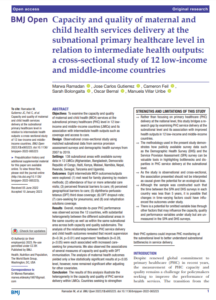
Objectives: To examine the capacity and quality of maternal and child health (MCH) services at the subnational primary healthcare (PHC) level in 12 low-income and middle-income countries (LMICs) and its association with intermediate health outputs such as coverage and access to care.
Design: Observational cross-sectional study using matched subnational data from service provision assessment surveys and demographic health surveys from 2007 to 2019.
Settings: 138 subnational areas with available survey data in 12 LMICs (Afghanistan, Bangladesh, Democratic Republic of Congo, Haiti, Kenya, Malawi, Namibia, Nepal, Rwanda, Senegal, Tanzania and Uganda).
Outcomes: Eight intermediate MCH outcomes/outputs were explored: (1) met need for family planning by modern methods; (2) attendance of four or more antenatal care visits; (3) perceived financial barriers to care; (4) perceived geographical barriers to care; (5) diphtheria-pertussis-tetanus (DPT) third dose coverage; (6) DPT dropout-rate; (7) care-seeking for pneumonia; and (8) oral rehydration solutions coverage.
Results: Overall, moderate-to-poor PHC performance was observed across the 12 countries, with substantial heterogeneity between the different subnational areas in the same country as well as within the same subnational area across both capacity and quality subdomains. The analysis of the relationship between PHC service delivery and child health outcomes revealed that recent supervision (b=0.34, p<0.01) and supervisors’ feedback (b=0.28, p<0.05) were each associated with increased care-seeking for pneumonia. We also observed the associations of several measures of capacity and quality with DPT immunisation. The analysis of maternal health outcomes yielded only a few statistically significant results at p<0.05 level, however, none remained significant after adjusting for other covariates.
Conclusion: The results of this analysis illustrate the heterogeneity in the capacity and quality of PHC service delivery within LMICs. Countries seeking to strengthen their PHC systems could improve PHC monitoring at the subnational level to better understand subnational bottlenecks in service delivery.